It was another rather nice day in Washington DC and we decided to grill outside. I was sent by-she-who-must-be-obeyed to the near-by Whole food market to get fresh whole fish. I got fish (trout, nothing else looked great). While there I could not resist buying sliced pork belly or "Bara-niku" バラ肉 which is a very common cut in Japan but we can get it only at this store around here. It is essentially "raw" (as in not smoked or cured) bacon meat. Since we were grilling our trout on a charcoal fire, I decided to make skewers using the pork belly. I was not thinking of any specific recipe but, since I also got mission figs at the same store, I decided to wrap the figs with pork belly. I first cut the figs into quarters and then wrapped them and skewered them for grilling.
I also had pencil asparagus already blanched and ready to go, I wrapped them in pork belly as well (below picture). I seasoned it salt and pepper before grilling.
I am sure this is not good for you but grilled pork belly with crispy edges and sweet figs inside (grilling enhanced the sweetness of the fig) cannot go wrong. My wife asked me to grill the pieces more after fig/pork belly was removed from the skewers to make all the surfaces crispy even the ones between the pieces on the skewer.
The asparagus joined in later.
We enjoyed this delectable pork belly as a starter with a red wine. We then started on our trout. This time, I simply salted them (after scaling).
We really enjoyed the simply prepared trout. We did not need any thing else with the fish. Salt and charcoal fire really make the fish taste good.
As an ending dish, I made our usual grilled rice balls but this time, I made sweet miso sauce (miso, sugar, mirin) and brushed it on towards the end of the cooking (below).
I happened to make beer pickles the prior weekend and served it (daikon, carrot, and cucumber) on the side.
The daikon was the same extremely "hot" one we tasted as grated daikon and was very spicy even as pickles. I sort of liked it but my wife thought her stomach could not take it.
Saturday, October 10, 2015
Wednesday, October 7, 2015
Grilled corn and black bean salad 焼きとうもろこしとブラックビーンのサラダ
This is a variation on a previously (5 years ago) posted recipe corn and black bean salad. After tasting grilled corn in a salad my wife got from the grocery store recently, she was inspired to try grilling rather and the usual microwaving of the corn for this salad. The added grilled flavor made this salad much better.
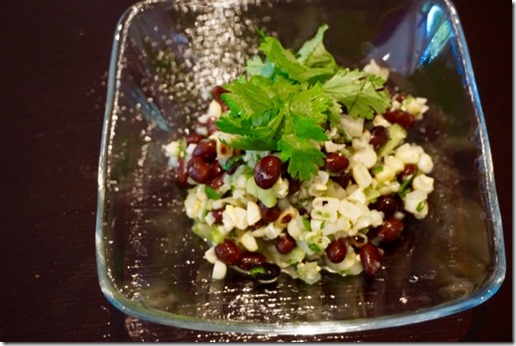
Since we could not grill the corns outside (mosquitos!), we decided to roast the fresh corn on a cast iron griddle (see below).

We brushed a small amount of olive oil on the corn and grilled it until surface got brown (see below) turning frequently. It smoked a bit although our exhaust fan handled it well. Next time, we may grill it without the oil.
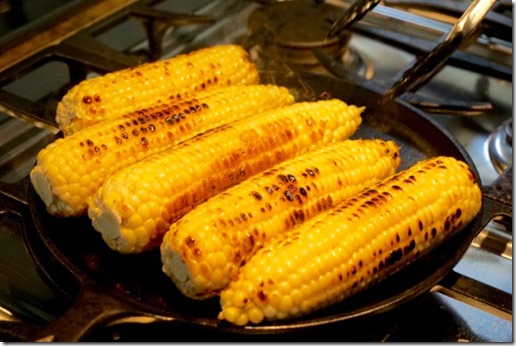
Using a chefs knife and standing up the cob on it's stem, I cut off the corn kernels.
Ingredients:
Grilled fresh corn: 6 ears, kernels removed.
Black beans: 16 oz can, drained.
Jalapeno pepper: 1 veined and seeds removed, finely chopped.
Fresh cilantro: Leaves finely chopped, 1/4 cup
Lemon juice freshly squeezed: 1 -2 lemon(s) or 3 tbs
Olive oil 3 tbs
Ground (roasted) cumin
Salt and ground black pepper
I mixed everything in a bowl and let it stand for several hours in the refrigerator.
The grilling process added a nice grilled flavor. This is a very refreshing summer salad.

Since we could not grill the corns outside (mosquitos!), we decided to roast the fresh corn on a cast iron griddle (see below).

We brushed a small amount of olive oil on the corn and grilled it until surface got brown (see below) turning frequently. It smoked a bit although our exhaust fan handled it well. Next time, we may grill it without the oil.

Using a chefs knife and standing up the cob on it's stem, I cut off the corn kernels.
Ingredients:
Grilled fresh corn: 6 ears, kernels removed.
Black beans: 16 oz can, drained.
Jalapeno pepper: 1 veined and seeds removed, finely chopped.
Fresh cilantro: Leaves finely chopped, 1/4 cup
Lemon juice freshly squeezed: 1 -2 lemon(s) or 3 tbs
Olive oil 3 tbs
Ground (roasted) cumin
Salt and ground black pepper
I mixed everything in a bowl and let it stand for several hours in the refrigerator.
The grilling process added a nice grilled flavor. This is a very refreshing summer salad.
Sunday, October 4, 2015
Marinated Bonito bowl 鰹のたたきの漬け丼
We had a frozen bonito tataki on Saturday but we had other dishes with it and could not finish it. So I quickly marinated the leftovers in a mixture of mirin, sake and soy sauce (1:1:2 ratio) with all the condiments (grated ginger, slices of garlic and scallion, and perilla) and made a bonito-tataki-zuke donburi 鰹のたたきの漬け丼 for lunch on Sunday. I also topped it with a poached egg with runny yolk (I used pasteurized eggs).
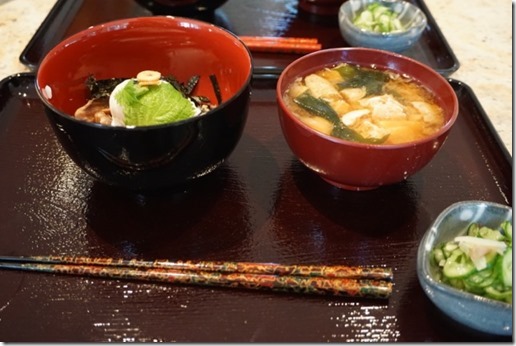
When we had tataki, I also made fried garlic chips in addition to raw ones, which I also added as a garnish.

As usual, I used frozen rice, mixed in a few teaspoons of sushi vinegar and microwaved to make sushi rice. I placed strips of nori, myoga, and perilla on top followed by slices of marinated tataki of bonito. I poached 2 eggs for 4-5 minutes and then soaked them in ice water to stop the cooking. After draining the eggs on a paper towel, I placed the poached eggs in the center of the bowel. I added more strips of nori, perilla leaves and garlic chips. I poured a small amount of the marinade over the rice as well.
I made miso soup with abura-age, wakame sea weed and tofu. I added thinly sliced myoga since I had it.

I also made cucumber and myoga salad (thinly sliced myoga and cucumber), salted, kneaded and let it stand for 10 minutes. Moisture squeezed out and then dressed in sushi vinegar.

For leftover control, this was a rather luxurious lunch. The poached egg with runny yolk was also very nice mixed in with rice and bonito.

When we had tataki, I also made fried garlic chips in addition to raw ones, which I also added as a garnish.

As usual, I used frozen rice, mixed in a few teaspoons of sushi vinegar and microwaved to make sushi rice. I placed strips of nori, myoga, and perilla on top followed by slices of marinated tataki of bonito. I poached 2 eggs for 4-5 minutes and then soaked them in ice water to stop the cooking. After draining the eggs on a paper towel, I placed the poached eggs in the center of the bowel. I added more strips of nori, perilla leaves and garlic chips. I poured a small amount of the marinade over the rice as well.
I made miso soup with abura-age, wakame sea weed and tofu. I added thinly sliced myoga since I had it.

I also made cucumber and myoga salad (thinly sliced myoga and cucumber), salted, kneaded and let it stand for 10 minutes. Moisture squeezed out and then dressed in sushi vinegar.

For leftover control, this was a rather luxurious lunch. The poached egg with runny yolk was also very nice mixed in with rice and bonito.
Thursday, October 1, 2015
Tuna and egg plant with mizore dressing 鮪とナスのみぞれ和え
This is another installment in my continuing quest to find a way to enjoy low-quality frozen blocks of yellowfin tuna. This is based on a recipe I saw on the web. But for a few reasons, this dish turned out to be not as good as it could have been. It is combination of cubes of tuna sashimi, steamed (microwaved) egg plant dressed in grated daikon.

Since we had just harvested fresh myoga, I use it for garnish.

Since I could not get a Japanese eggplant, I used a small Italian eggplant. As per the recipe, I wrapped it in plastic wrap and placed it in a silicon microwave container and microwaved it for a few minutes then let it cool with the wrap still on. After it reached room temperature, I cooled it further in the refrigerator. I cut both the eggplant and tuna into similar sized block pieces. I gave it my usual "yubiki" treatment and then coated with sashimi soy sauce (below).

I grated the daikon and drained out the liquid using a fine mesh strainer. I added a small amount of rice vinegar and soy sauce and mixed the tuna and eggplant with the grated daikon.
We had two problems with this particular dish and they both had to do with the quality of the ingredients we used (not the tuna this time). One was that the grated daikon was ridiculously and atomically hot! This is a bit unusual but daikon is from the horseradish family and some, like this one, exhibit their heritage to greater or lesser degrees. We actually had to remove the daikon in order to be able to eat the rest of the dish. Another problem was the quality of the egg plant. It had good amount of seeds, which I mostly removed, but it did not have the wonderful texture and taste of a Japanese eggplant. I would like to try this dish again using a milder daikon and better quality egg plant.

Since we had just harvested fresh myoga, I use it for garnish.

Since I could not get a Japanese eggplant, I used a small Italian eggplant. As per the recipe, I wrapped it in plastic wrap and placed it in a silicon microwave container and microwaved it for a few minutes then let it cool with the wrap still on. After it reached room temperature, I cooled it further in the refrigerator. I cut both the eggplant and tuna into similar sized block pieces. I gave it my usual "yubiki" treatment and then coated with sashimi soy sauce (below).

I grated the daikon and drained out the liquid using a fine mesh strainer. I added a small amount of rice vinegar and soy sauce and mixed the tuna and eggplant with the grated daikon.
We had two problems with this particular dish and they both had to do with the quality of the ingredients we used (not the tuna this time). One was that the grated daikon was ridiculously and atomically hot! This is a bit unusual but daikon is from the horseradish family and some, like this one, exhibit their heritage to greater or lesser degrees. We actually had to remove the daikon in order to be able to eat the rest of the dish. Another problem was the quality of the egg plant. It had good amount of seeds, which I mostly removed, but it did not have the wonderful texture and taste of a Japanese eggplant. I would like to try this dish again using a milder daikon and better quality egg plant.
Monday, September 28, 2015
Vinegard sanma sashimi 〆さんま
When I pontificated about sanma さんまor pacific saury, I mentioned that "sashimi" of sanma is not unusual now. (This is because of the improvements in distribution that get these perishable "blue" fish quickly to the market. One aspect of this improvement is that this formerly lowely fish has been “up-graded” in status and has become much more expensive in many sushi bars). I was surprised to see frozen and vinegared sanma or shime-sanma 〆さんま in the freezer case of our Japanese grocery store. Although vinegared mackerel or シメサバ is very common, I have never seen sanma sold this way and promptly bought it.
I served it with two kinds of cucumber salad (one with thinly sliced myoga and one with thinly sliced red onion, both salted, washed and then excess moisture wrung out and dressed in vinegar dressing). I also put both grated ginger and wasabi.
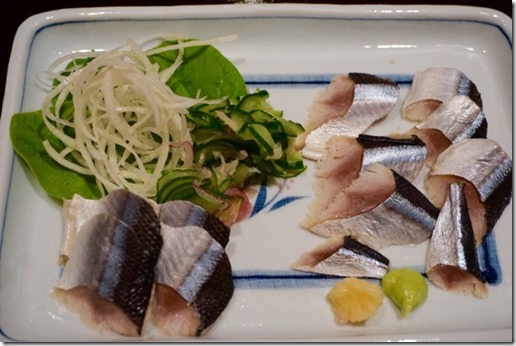
As you can see below, this is very well vinegared and the meat is all opaque (i.e. chemically cooked) which is the same in packaged frozen vinegared Mackerel.
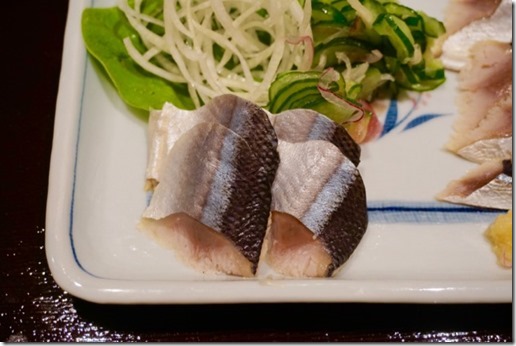
The below was how it came. One package had three filets of sanma.

After thawing, I blotted excess moisture and sliced it slightly obliquely.

 The shime sanma tasted very similar to shime saba or mackerel. The vinegar was a bit sweeter than I would like but my wife thought it was fine. As I mentioned, the meat was throughly vinegared and opaque. If the center was a bit closer to raw would have been better but I am asking too much.
The shime sanma tasted very similar to shime saba or mackerel. The vinegar was a bit sweeter than I would like but my wife thought it was fine. As I mentioned, the meat was throughly vinegared and opaque. If the center was a bit closer to raw would have been better but I am asking too much.
The only drink that goes with this is sake. This sake called "Tozai Living Jewel" is widely available in US and appears to be an export only brand from Kizakura brewery 黄桜酒造 in Kyoto, Japan. We have tasted turbid sake from them before called “snow maiden” “Tozai Yuki musume” 東西雪娘.
The current one is "junmai shu" 純米酒 and it is not too yeasty, Although it does not have depth or complex flavors or fruity note (which is more from ginjo and daiginjo flavors) and the taste disappears quickly in the palate (i.e. short finish), it is quite a drinkable sake. This one went particularly well with a strong oily fish with vinegar and sweet taste of vinegared sanma we were having.
So, we enjoyed this dish and sake.
I served it with two kinds of cucumber salad (one with thinly sliced myoga and one with thinly sliced red onion, both salted, washed and then excess moisture wrung out and dressed in vinegar dressing). I also put both grated ginger and wasabi.

As you can see below, this is very well vinegared and the meat is all opaque (i.e. chemically cooked) which is the same in packaged frozen vinegared Mackerel.

The below was how it came. One package had three filets of sanma.

After thawing, I blotted excess moisture and sliced it slightly obliquely.

 The shime sanma tasted very similar to shime saba or mackerel. The vinegar was a bit sweeter than I would like but my wife thought it was fine. As I mentioned, the meat was throughly vinegared and opaque. If the center was a bit closer to raw would have been better but I am asking too much.
The shime sanma tasted very similar to shime saba or mackerel. The vinegar was a bit sweeter than I would like but my wife thought it was fine. As I mentioned, the meat was throughly vinegared and opaque. If the center was a bit closer to raw would have been better but I am asking too much.The only drink that goes with this is sake. This sake called "Tozai Living Jewel" is widely available in US and appears to be an export only brand from Kizakura brewery 黄桜酒造 in Kyoto, Japan. We have tasted turbid sake from them before called “snow maiden” “Tozai Yuki musume” 東西雪娘.
The current one is "junmai shu" 純米酒 and it is not too yeasty, Although it does not have depth or complex flavors or fruity note (which is more from ginjo and daiginjo flavors) and the taste disappears quickly in the palate (i.e. short finish), it is quite a drinkable sake. This one went particularly well with a strong oily fish with vinegar and sweet taste of vinegared sanma we were having.
So, we enjoyed this dish and sake.
Friday, September 25, 2015
Pumpkin cheese spread パンプキンチーズスプレッド
This is another installment in the pumpkin puree recipe series. This was originally a cheese ball recipe but we did not make it to balls and just used it as a cheese spread. This is perfect with sipping wine.

Ingredients:
8 ounces goat cheese,
2 cups grated manchego,
3/4 cup pumpkin
1/2 teaspoon each smoked paprika and kosher salt.

The original recipe said "pulse" the goat cheese but that does not work--the goat cheese is too thick to "pulse" successfully. (sometimes you have to wonder if the folks who publish the recipes have actually made them.) After the food blender stalled out I removed the half blended ingredients and mixed them by hand with a spatula (you can see the white specks of unblended goat cheese in the picture). My suggestion is to cream the goat cheese in a mixer then add the other ingredients. It would probably also be useful to have all the ingredients at room temperature
In any case, the mixture of manchego and fresh goat cheese gives very nice texture and taste. The addition of smoked paprika and pumpkin puree adds an interesting and complex flavor with a slight sweetness. We like this as a cheese spread and as I said before it tastes great with red wine.

Ingredients:
8 ounces goat cheese,
2 cups grated manchego,
3/4 cup pumpkin
1/2 teaspoon each smoked paprika and kosher salt.

The original recipe said "pulse" the goat cheese but that does not work--the goat cheese is too thick to "pulse" successfully. (sometimes you have to wonder if the folks who publish the recipes have actually made them.) After the food blender stalled out I removed the half blended ingredients and mixed them by hand with a spatula (you can see the white specks of unblended goat cheese in the picture). My suggestion is to cream the goat cheese in a mixer then add the other ingredients. It would probably also be useful to have all the ingredients at room temperature
In any case, the mixture of manchego and fresh goat cheese gives very nice texture and taste. The addition of smoked paprika and pumpkin puree adds an interesting and complex flavor with a slight sweetness. We like this as a cheese spread and as I said before it tastes great with red wine.
Tuesday, September 22, 2015
Pumpkin pancake パンプキンパンケーキ
Our favorite pancake is blueberry butter milk pancake. During blueberry season we make a batch of these pancakes almost every weekend and freeze the extras we make. They freeze very well. After making the “super secret” pumpkin bread we had canned pumpkin left over so, in keeping with the season, we decided to make pumpkin pancakes. I usually use 4 identical non-stick 8 inch frying pans to make a batch of pancakes. I could make the pancakes without oil or butter in the pan but my wife informed me that the oil is essential for the crispy "fried" edges she likes. My wife found this recipe on line.

Compared to our buttermilk pancakes, these really puffed up much higher. We enjoyed them with small amount of maple syrup and a side of espresso coffee.

The below is a direct quote from the original recipe (italicized) with our modification in parentheses.
Ingredients:
 This made a total of 10 pancakes. Here is the picture of the 8 remaining pancakes (we ate two). In addition to the pumpkin pie spice called for in this recipe, we did not have evaporated milk either. We have not used or bought evaporated milk for ages. So in addition to making our own pumpkin pie spice, we also made our own evaporated milk. I know what you are thinking; that we have entirely too much time on our hand to do something as silly as that but there were extenuating circumstances. First, we really wanted to make these pancakes, second we had some excess milk that we were wondering what to do with before it went bad. We consulted the internet and found it was fairly easy to make evaporated milk--just simmer a quart of milk until it is reduced by half. (While the process of actually making the evaporated milk was easy, cleaning the pan was not. Trust me, it is worth it to buy it in a can). It took half a day to make and the end product had chunks of "scum" or "membrane" (I assume from the milk protein). We strained the liquid and the end result was fairly thick, deep cream color and tasted pretty good. The funny thing is that this recipe calls for evaporated milk and then adds water. Why not just use regular milk? After all that work we were not about to add water so we used enough regular milk to make the batter of pouring consistency. We have a feeling that just adding milk or a mixture of milk and cream may do just as well as evaporated milk and water.
This made a total of 10 pancakes. Here is the picture of the 8 remaining pancakes (we ate two). In addition to the pumpkin pie spice called for in this recipe, we did not have evaporated milk either. We have not used or bought evaporated milk for ages. So in addition to making our own pumpkin pie spice, we also made our own evaporated milk. I know what you are thinking; that we have entirely too much time on our hand to do something as silly as that but there were extenuating circumstances. First, we really wanted to make these pancakes, second we had some excess milk that we were wondering what to do with before it went bad. We consulted the internet and found it was fairly easy to make evaporated milk--just simmer a quart of milk until it is reduced by half. (While the process of actually making the evaporated milk was easy, cleaning the pan was not. Trust me, it is worth it to buy it in a can). It took half a day to make and the end product had chunks of "scum" or "membrane" (I assume from the milk protein). We strained the liquid and the end result was fairly thick, deep cream color and tasted pretty good. The funny thing is that this recipe calls for evaporated milk and then adds water. Why not just use regular milk? After all that work we were not about to add water so we used enough regular milk to make the batter of pouring consistency. We have a feeling that just adding milk or a mixture of milk and cream may do just as well as evaporated milk and water.
We really like this pancake. It has a nice pumpkin and pumpkin spice flavor and is nicely moist and fluffy. The canned pumpkin adds some mild sweetness. The toasted pecans added a nice crunch. These pancakes, like the blueberry pancakes also freeze very well. We took these to work for breakfast and they revived nicely in the microwave oven.

Compared to our buttermilk pancakes, these really puffed up much higher. We enjoyed them with small amount of maple syrup and a side of espresso coffee.

The below is a direct quote from the original recipe (italicized) with our modification in parentheses.
Ingredients:
2 cups all-purpose flourInstructions:
2 tablespoons packed brown sugar
1 tablespoon baking powder
1 1/4 teaspoons pumpkin pie spice
1 teaspoon salt
1 can (12 fl. oz.) Evaporated Milk (We made our own
1/2 cup Pumpkin puree
1/4 cup water
1 large egg
2 tablespoons vegetable oil
Chopped pecan (we first roasted and chopped)
Toast about a cup of pecans, mix flour, brown sugar, baking powder, pumpkin pie spice and salt in large bowl. Combine evaporated milk, pumpkin, water (we actually just used regular milk), egg and 2 tablespoons oil in small bowl; mix well. Add to flour mixture. Stir just until moistened; batter may be lumpy. (Stir in chopped pecans.)
HEAT griddle or skillet over medium heat; brush lightly with oil. Pour 1/4 cup batter onto hot griddle; cook until bubbles begin to burst. Turn and continue cooking for 1 to 2 minutes. Repeat with remaining batter. Serve with Pumpkin maple syrup (We just used straight maple syrup).
 This made a total of 10 pancakes. Here is the picture of the 8 remaining pancakes (we ate two). In addition to the pumpkin pie spice called for in this recipe, we did not have evaporated milk either. We have not used or bought evaporated milk for ages. So in addition to making our own pumpkin pie spice, we also made our own evaporated milk. I know what you are thinking; that we have entirely too much time on our hand to do something as silly as that but there were extenuating circumstances. First, we really wanted to make these pancakes, second we had some excess milk that we were wondering what to do with before it went bad. We consulted the internet and found it was fairly easy to make evaporated milk--just simmer a quart of milk until it is reduced by half. (While the process of actually making the evaporated milk was easy, cleaning the pan was not. Trust me, it is worth it to buy it in a can). It took half a day to make and the end product had chunks of "scum" or "membrane" (I assume from the milk protein). We strained the liquid and the end result was fairly thick, deep cream color and tasted pretty good. The funny thing is that this recipe calls for evaporated milk and then adds water. Why not just use regular milk? After all that work we were not about to add water so we used enough regular milk to make the batter of pouring consistency. We have a feeling that just adding milk or a mixture of milk and cream may do just as well as evaporated milk and water.
This made a total of 10 pancakes. Here is the picture of the 8 remaining pancakes (we ate two). In addition to the pumpkin pie spice called for in this recipe, we did not have evaporated milk either. We have not used or bought evaporated milk for ages. So in addition to making our own pumpkin pie spice, we also made our own evaporated milk. I know what you are thinking; that we have entirely too much time on our hand to do something as silly as that but there were extenuating circumstances. First, we really wanted to make these pancakes, second we had some excess milk that we were wondering what to do with before it went bad. We consulted the internet and found it was fairly easy to make evaporated milk--just simmer a quart of milk until it is reduced by half. (While the process of actually making the evaporated milk was easy, cleaning the pan was not. Trust me, it is worth it to buy it in a can). It took half a day to make and the end product had chunks of "scum" or "membrane" (I assume from the milk protein). We strained the liquid and the end result was fairly thick, deep cream color and tasted pretty good. The funny thing is that this recipe calls for evaporated milk and then adds water. Why not just use regular milk? After all that work we were not about to add water so we used enough regular milk to make the batter of pouring consistency. We have a feeling that just adding milk or a mixture of milk and cream may do just as well as evaporated milk and water.We really like this pancake. It has a nice pumpkin and pumpkin spice flavor and is nicely moist and fluffy. The canned pumpkin adds some mild sweetness. The toasted pecans added a nice crunch. These pancakes, like the blueberry pancakes also freeze very well. We took these to work for breakfast and they revived nicely in the microwave oven.
Subscribe to:
Posts (Atom)







